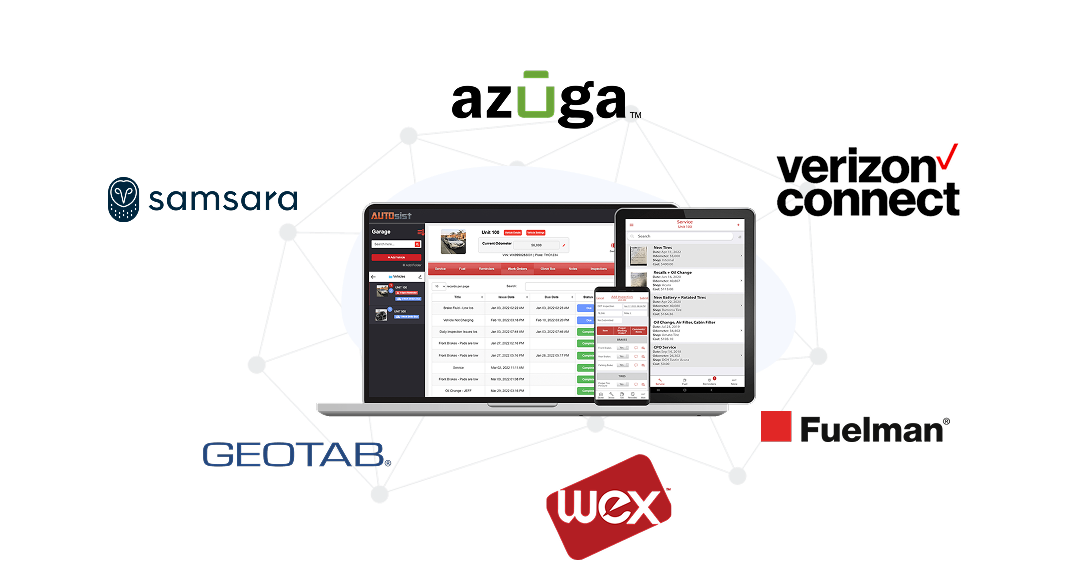 Miya Bholat
Miya Bholat
Sep 30, 2025
How Integrated Fleet Management Software Connects Your Entire Operation

Running a fleet today means juggling dozens of different systems, devices, and data sources. Your GPS tracking shows where vehicles are, fuel cards reveal spending patterns, dash cameras capture safety incidents, and maintenance schedules live in yet another system. Sound familiar? If you're tired of switching between multiple platforms just to get a complete picture of your fleet's performance, you're not alone.
The good news? Modern integrated fleet management software is changing the game by bringing all these disparate pieces together into one cohesive platform. Let's explore how this integration works and why it's becoming essential for fleet operations of all sizes.
What Does "Integrated" Fleet Software Mean?
When we talk about integrated fleet management software, we're referring to platforms that can connect with and pull data from multiple sources automatically. Instead of manually logging into five different systems to check on your fleet, everything flows into a single dashboard where you can see the complete picture.
Think of it like having a universal remote for your entire fleet operation. One interface, complete control, and all your data working together instead of sitting in isolated silos.
The Key Integrations That Transform Fleet Management
GPS Tracking and Telematics Integration
Your GPS tracking devices are constantly collecting valuable data about vehicle locations, routes, idle time, and driving behaviors. When this data integrates seamlessly with your fleet management platform, you get real-time visibility into operations without manually checking separate tracking systems.
This integration enables automatic route optimization, geofencing alerts, and detailed reporting on driver performance—all within your main fleet management interface. You'll know instantly when a vehicle deviates from its planned route or when a driver exhibits unsafe behaviors like harsh braking or rapid acceleration.
Fuel Card System Connectivity
Fuel expenses typically represent one of the largest costs in fleet operations, yet many companies struggle to track and control these expenses effectively. Integrated fuel card connectivity changes this by automatically importing transaction data directly into your fleet management system.
This means you can instantly see which vehicles are consuming the most fuel, identify unusual spending patterns, and even detect potential fraud—all without manually entering receipt data or waiting for monthly statements. The system can flag transactions that seem out of place, like fuel purchases made outside normal operating hours or in unexpected locations.
Safety Dash Camera Integration
Modern dash cameras do more than just record video. When integrated with fleet management software, they become powerful tools for improving driver safety and reducing liability. The integration allows for automatic incident detection, where the system can identify events like hard braking, collisions, or lane departures and immediately flag the corresponding video footage.
This seamless connection means safety managers don't have to manually review hours of footage. Instead, they receive alerts for specific incidents and can access the relevant video clips directly through the fleet management platform. This integration also enables coaching opportunities by providing concrete examples of both safe and unsafe driving behaviors.
Comprehensive Maintenance System
Vehicle maintenance is critical for safety, efficiency, and cost control, but keeping track of service schedules across an entire fleet can be overwhelming. Integrated maintenance management automatically tracks mileage, engine hours, and other vehicle metrics to predict when service is needed.
The system can pull diagnostic trouble codes directly from vehicles, schedule preventive maintenance based on actual usage patterns, and even integrate with parts inventory systems to ensure necessary components are available when needed. This proactive approach helps prevent costly breakdowns and extends vehicle life.
Inventory and Parts Management
Speaking of parts, integrated inventory management ensures you always have the right components available when maintenance is needed. The system can automatically reorder frequently used parts when stock levels get low and track which parts are used on which vehicles for better cost analysis.
This integration eliminates the guesswork from inventory management and helps fleet managers understand the true cost of operating each vehicle, including parts and labor expenses over time.
The Benefits of True Fleet System Integrations
Single Source of Truth
When all your fleet data flows into one integrated platform, you eliminate the confusion that comes from having multiple systems with potentially conflicting information. Everyone in your organization works from the same real-time data, improving decision-making and reducing errors.
Automated Workflows
Integration enables powerful automation that would be impossible with disconnected systems. For example, when a vehicle shows signs of mechanical issues through telematics data, the system can automatically schedule maintenance, order necessary parts, and notify the appropriate personnel—all without manual intervention.
Enhanced Analytics and Reporting
With all your fleet data in one place, you can perform more sophisticated analysis and generate comprehensive reports that would be impossible with siloed systems. You might discover that vehicles with certain driving patterns require maintenance more frequently, or that specific routes are more fuel-efficient than others.
Improved Compliance Management
Many fleet operations must comply with various regulations, from DOT requirements to environmental standards. Integrated systems make compliance easier by automatically tracking relevant metrics and generating required reports without manual data compilation.
Cost Reduction and ROI
While integrated fleet management systems require an initial investment, they typically pay for themselves through improved efficiency, reduced fuel costs, fewer maintenance surprises, and decreased administrative overhead. When systems work together seamlessly, your team can focus on strategic improvements rather than data entry and manual coordination.
Making Integration Work for Your Fleet
The key to successful integration lies in choosing a fleet management platform that offers robust API connections and pre-built integrations with the systems you already use. Look for solutions that can adapt to your existing workflow rather than forcing you to completely overhaul your operations.
Consider starting with the integrations that will have the biggest immediate impact on your operation. For many fleets, this means beginning with GPS tracking and fuel card integration, then gradually adding other systems as you see the benefits.
As fleet operations become more complex and data-driven, the ability to integrate multiple systems isn't just nice to have—it's essential for staying competitive. Fleet managers who embrace integrated solutions today will be better positioned to adapt to future challenges and opportunities.
The days of juggling multiple logins, manually correlating data from different systems, and making decisions based on incomplete information are quickly coming to an end. Integrated fleet management software represents the future of fleet operations, where all your systems work together to provide unprecedented visibility, control, and efficiency.
Ready to see how integration can transform your fleet operation? The time to consolidate your systems and streamline your processes is now. Your drivers, your bottom line, and your sanity will thank you for it. Start your free trial of AUTOsist or request a demo today!